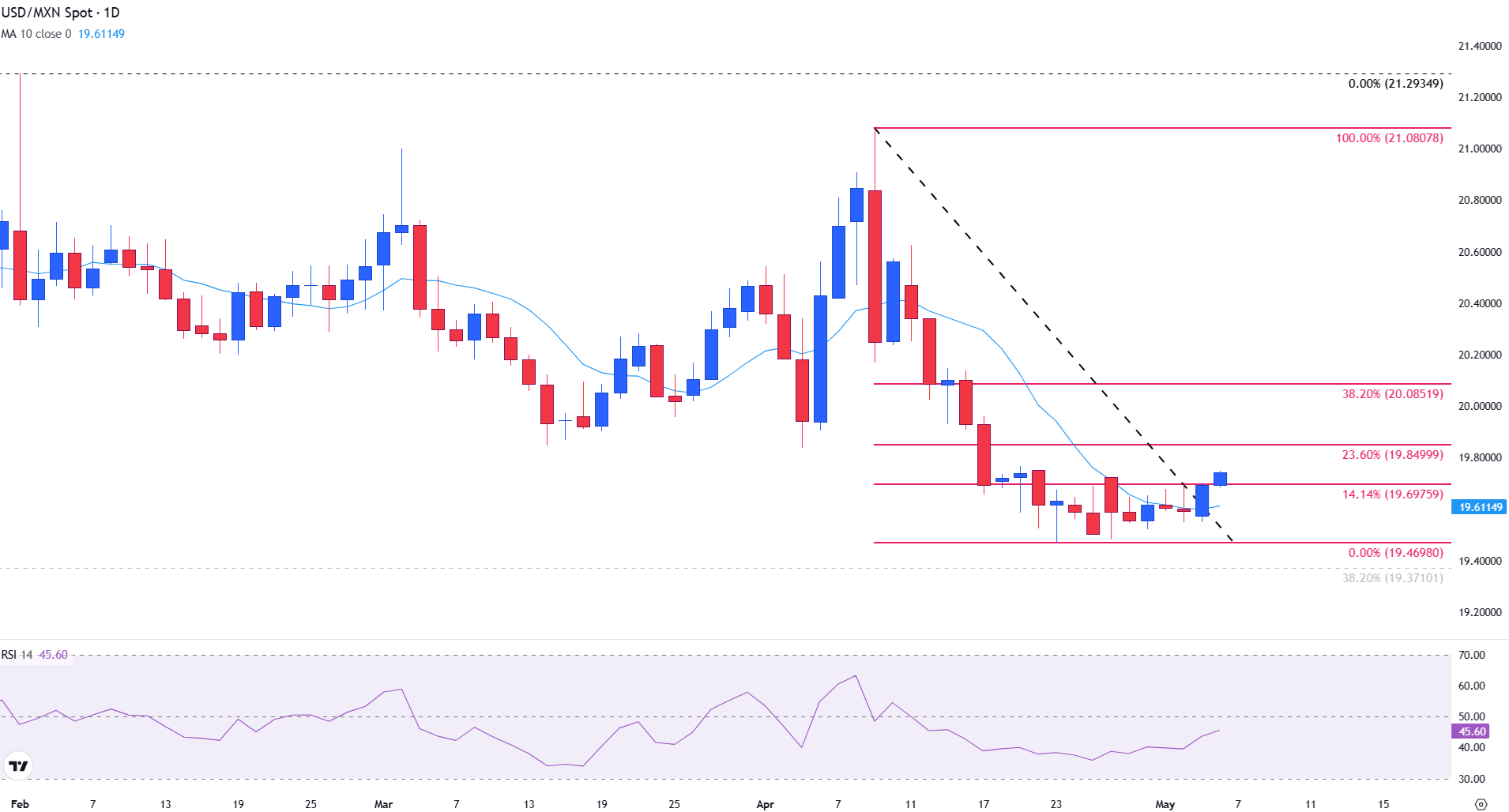- Mexican Peso softens as cautious risk tone builds ahead of Fed decision.
- Geopolitical strains between Mexico and the United States linger, though market response remains muted.
- USD/MXN supported by firmer US yields and cautious Fed repricing.
Mexican Peso stalls as markets remain focused on the Fed
The Mexican Peso (MXN) is trading lower against the US Dollar (USD) on Tuesday as markets brace for the Federal Reserve’s (Fed) monetary policy decision on Wednesday.
USD/MXN is up 0.26% on the day, trading near 19.75 at the time of writing, after breaking above a key trendline and extending gains from Monday.
The move reflects a shift in risk sentiment, as recent US data has challenged expectations for early interest rate cuts. With investors repositioning ahead of Fed Chair Jerome Powell’s comments, demand for the US Dollar has strengthened while the Peso and other Emerging Market (EM) currencies have lagged.
US economic resilience tempers bearish bias for the Greenback
The latest move higher in USD/MXN has been driven by mixed signals from the US services sector. On Monday, the Institute for Supply Management (ISM) Services Purchasing Managers Index (PMI) surprised to the upside, rising to 51.6 in April, above the 50.4 consensus and the 50.8 reading in the previous month, suggesting ongoing resilience in the services sector business activity.
In contrast, the S&P Global US Services PMI dropped to 50.8, missing the preliminary estimate of 51.4 and marking the slowest pace of expansion in two years. The divergence points to an uneven economic recovery, with larger firms likely performing better than smaller, internationally exposed businesses.
For markets, the ISM report carried more weight, helping lift US Treasury yields modestly and refocusing attention on the Federal Reserve’s monetary policy path. Higher yields increase the appeal of the US Dollar, while risk-sensitive assets like the Mexican Peso tend to underperform.
Meanwhile, political tensions between Mexico and the United States remain in the background.
Over the weekend, Mexican President Claudia Sheinbaum publicly rejected an offer by US President Donald Trump to deploy American troops in Mexico to fight drug cartels. Sheinbaum reaffirmed Mexico’s sovereignty, stating: “We can work together, but you in your territory and us in ours.”
Although the development has drawn diplomatic attention, markets have treated it as a background risk with limited direct impact on USD/MXN price action.
Mexican Peso daily digest: FOMC takes centre stage
- The Federal Open Market Committee (FOMC) is expected to keep the benchmark interest rate steady in the 4.25%-4.50% range on Wednesday. However, market focus will be on the tone of Chair Jerome Powell’s press conference for any signal on the timing of rate cuts.
- According to the CME FedWatch Tool, traders are pricing in a 25 basis-point (bps) rate cut in July, though expectations have eased slightly following Monday’s ISM beat. A dovish tone from Powell could weaken the US Dollar and lift the Peso.
- The Bank of Mexico (Banxico) is expected to deliver another 50 bps cut at its next meeting on May 15. Mexican Q1 Gross Domestic Product (GDP) rose just 0.2%, narrowly avoiding recession, while inflation continues to cool. Banxico has maintained a cautious, data-driven approach.
- Recent US tariffs on key Mexican exports – including metals and autos – have added pressure to the external sector, weighing on trade and investment outlooks.
- Uncertainty surrounding global demand, commodity prices, and future US trade or immigration policy continues to cloud the outlook for emerging market assets like the Mexican Peso.
USD/MXN bulls take the lead
From a technical perspective, USD/MXN has broken above a descending trendline resistance drawn from the April high of 21.08, indicating a potential shift in short-term bias.
The pair is now trading above the 14.14% Fibonacci retracement level of the April move, providing support at 19.698.
With the pair currently trading at its highest level in nearly two weeks, the 10-day Simple Moving Average (SMA) is now providing an additional layer of support at 19.611.
Momentum indicators are improving, with the relative strength index (RSI) approaching the neutral level of 50, suggesting downside momentum has faded. Resistance is now in focus at the psychological barrier of 19.80, followed by the 23.6% Fibonacci retracement of the April move at 19.85.
On the downside, the reclaimed trendline and the 19.59 – 19.60 zone offer initial support, with stronger support seen at the April low of 19.47.
USD/MXN daily chart

Fed FAQs
Monetary policy in the US is shaped by the Federal Reserve (Fed). The Fed has two mandates: to achieve price stability and foster full employment. Its primary tool to achieve these goals is by adjusting interest rates.
When prices are rising too quickly and inflation is above the Fed’s 2% target, it raises interest rates, increasing borrowing costs throughout the economy. This results in a stronger US Dollar (USD) as it makes the US a more attractive place for international investors to park their money.
When inflation falls below 2% or the Unemployment Rate is too high, the Fed may lower interest rates to encourage borrowing, which weighs on the Greenback.
The Federal Reserve (Fed) holds eight policy meetings a year, where the Federal Open Market Committee (FOMC) assesses economic conditions and makes monetary policy decisions.
The FOMC is attended by twelve Fed officials – the seven members of the Board of Governors, the president of the Federal Reserve Bank of New York, and four of the remaining eleven regional Reserve Bank presidents, who serve one-year terms on a rotating basis.
In extreme situations, the Federal Reserve may resort to a policy named Quantitative Easing (QE). QE is the process by which the Fed substantially increases the flow of credit in a stuck financial system.
It is a non-standard policy measure used during crises or when inflation is extremely low. It was the Fed’s weapon of choice during the Great Financial Crisis in 2008. It involves the Fed printing more Dollars and using them to buy high grade bonds from financial institutions. QE usually weakens the US Dollar.
Quantitative tightening (QT) is the reverse process of QE, whereby the Federal Reserve stops buying bonds from financial institutions and does not reinvest the principal from the bonds it holds maturing, to purchase new bonds. It is usually positive for the value of the US Dollar.

